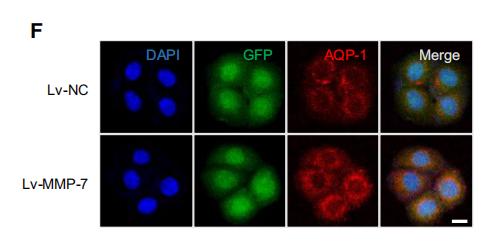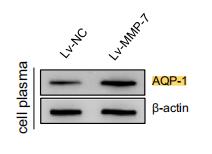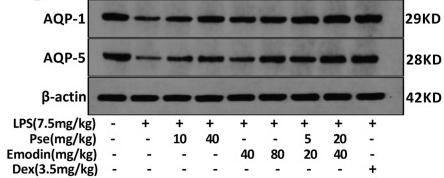AQP1 Antibody - #AF5231
| Product: | AQP1 Antibody |
| Catalog: | AF5231 |
| Description: | Rabbit polyclonal antibody to AQP1 |
| Application: | WB IHC IF/ICC |
| Cited expt.: | WB, IF/ICC |
| Reactivity: | Human, Mouse, Rat |
| Prediction: | Horse, Dog |
| Mol.Wt.: | 29kDa,35-50kDa(Glycosylation); 29kD(Calculated). |
| Uniprot: | P29972 |
| RRID: | AB_2837717 |
Related Downloads
Protocols
Product Info
*The optimal dilutions should be determined by the end user. For optimal experimental results, antibody reuse is not recommended.
*Tips:
WB: For western blot detection of denatured protein samples. IHC: For immunohistochemical detection of paraffin sections (IHC-p) or frozen sections (IHC-f) of tissue samples. IF/ICC: For immunofluorescence detection of cell samples. ELISA(peptide): For ELISA detection of antigenic peptide.
Cite Format: Affinity Biosciences Cat# AF5231, RRID:AB_2837717.
Fold/Unfold
AQP 1; AQP CHIP; AQP-1; AQP1; AQP1_HUMAN; aquaporin 1 (channel-forming integral protein, 28kDa, CO blood group); aquaporin 1 (Colton blood group); Aquaporin CHIP; Aquaporin-1; Aquaporin-CHIP; Aquaporin1; Channel forming integral protein 28kDa; Channel like integral membrane protein 28 kDa; CHIP 28; CHIP28; CO; Colton blood group; Growth factor induced delayed early response protein; MGC26324; Urine water channel; Water channel protein CHIP 29; Water channel protein CHIP29; Water channel protein for red blood cells and kidney proximal tubule;
Immunogens
A synthesized peptide derived from human AQP1, corresponding to a region within the internal amino acids.
Detected in erythrocytes (at protein level). Expressed in a number of tissues including erythrocytes, renal tubules, retinal pigment epithelium, heart, lung, skeletal muscle, kidney and pancreas. Weakly expressed in brain, placenta and liver.
- P29972 AQP1_HUMAN:
- Protein BLAST With
- NCBI/
- ExPASy/
- Uniprot
MASEFKKKLFWRAVVAEFLATTLFVFISIGSALGFKYPVGNNQTAVQDNVKVSLAFGLSIATLAQSVGHISGAHLNPAVTLGLLLSCQISIFRALMYIIAQCVGAIVATAILSGITSSLTGNSLGRNDLADGVNSGQGLGIEIIGTLQLVLCVLATTDRRRRDLGGSAPLAIGLSVALGHLLAIDYTGCGINPARSFGSAVITHNFSNHWIFWVGPFIGGALAVLIYDFILAPRSSDLTDRVKVWTSGQVEEYDLDADDINSRVEMKPK
Predictions
Score>80(red) has high confidence and is suggested to be used for WB detection. *The prediction model is mainly based on the alignment of immunogen sequences, the results are for reference only, not as the basis of quality assurance.
High(score>80) Medium(80>score>50) Low(score<50) No confidence
Research Backgrounds
Forms a water-specific channel that provides the plasma membranes of red cells and kidney proximal tubules with high permeability to water, thereby permitting water to move in the direction of an osmotic gradient.
Cell membrane>Multi-pass membrane protein.
Detected in erythrocytes (at protein level). Expressed in a number of tissues including erythrocytes, renal tubules, retinal pigment epithelium, heart, lung, skeletal muscle, kidney and pancreas. Weakly expressed in brain, placenta and liver.
Aquaporins contain two tandem repeats each containing three membrane-spanning domains and a pore-forming loop with the signature motif Asn-Pro-Ala (NPA).
Belongs to the MIP/aquaporin (TC 1.A.8) family.
Research Fields
· Organismal Systems > Endocrine system > Renin secretion.
· Organismal Systems > Excretory system > Proximal tubule bicarbonate reclamation.
References
Application: IF/ICC Species: Mouse Sample: renal tissue
Application: IF/ICC Species: Human Sample: peritoneal mesothelial cells
Application: WB Species: Human Sample: peritoneal mesothelial cells
Application: WB Species: Rat Sample: lung tissues
Application: WB Species: human Sample: BC tissues and cell lines
Restrictive clause
Affinity Biosciences tests all products strictly. Citations are provided as a resource for additional applications that have not been validated by Affinity Biosciences. Please choose the appropriate format for each application and consult Materials and Methods sections for additional details about the use of any product in these publications.
For Research Use Only.
Not for use in diagnostic or therapeutic procedures. Not for resale. Not for distribution without written consent. Affinity Biosciences will not be held responsible for patent infringement or other violations that may occur with the use of our products. Affinity Biosciences, Affinity Biosciences Logo and all other trademarks are the property of Affinity Biosciences LTD.







